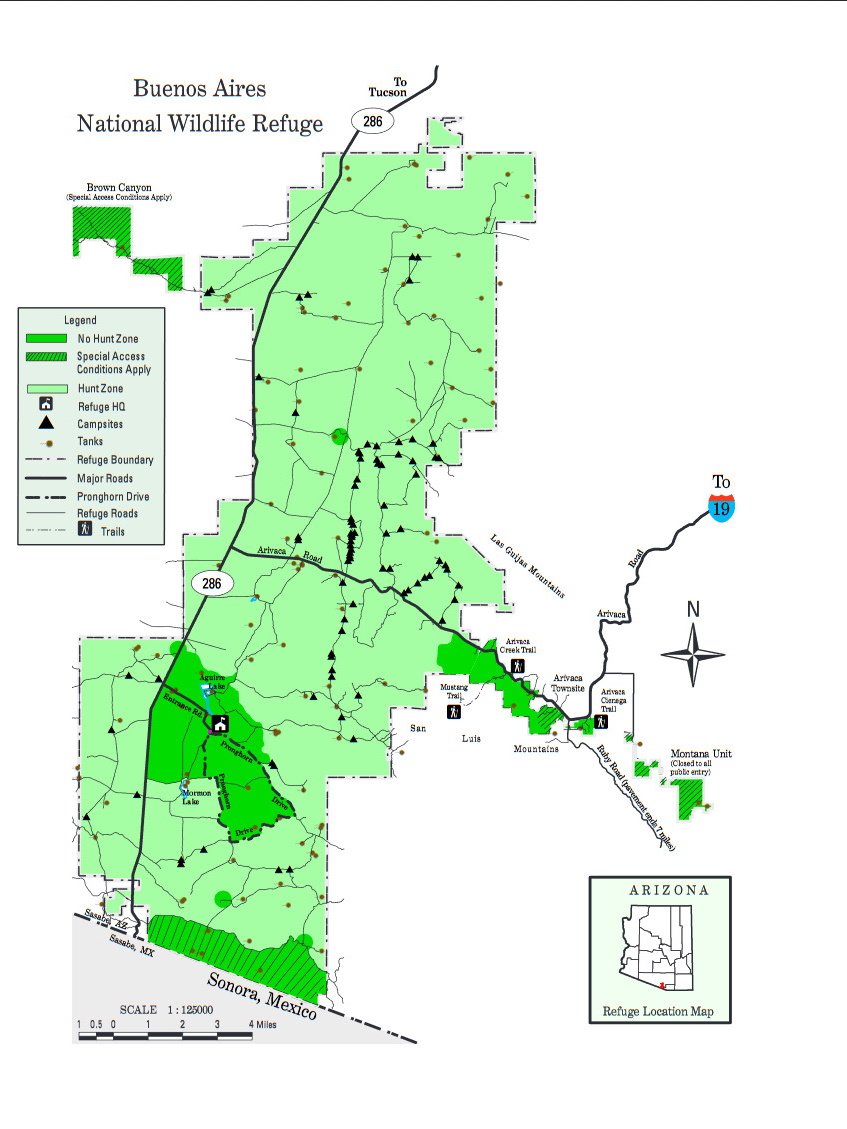Buenos Aires NWR--Brown Canyon (restricted access)
Buenos Aires NWR--Brown Canyon (restricted access)
Sasabe, Arizona 85633
Buenos Aires National Wildlife Refuge Official WebsiteBuenos Aires National Wildlife Refuge map
Buenos Aires National Wildlife Refuge Trails
Tips for Birding
Brown Canyon is one of ten location-specific hotspots within Buenos Aires National Wildlife Refuge. Use the greater Refuge hotspot when you have a checklist that includes multiple locations.
Blue-gray and Black-tailed Gnatcatcher may present an identification challenge warranting advance review of calls. Note that a Black-capped Gnatcatcher was photographed here in 2016.
Birds of Interest
Over the 5-year period 2019-2023, no checklists were submitted for this hotspot during the final 4 months of the calendar year. From September 2021 through end of 2023, only a single checklist was submitted. Therefore, recent eBird records may not fully document current species frequency for the site.
The threatened Yellow-billed Cuckoo has been observed Jul-Aug.
Broad-tailed Hummingbird (Apr and Jul-Aug), Gila Woodpecker (all year), Arizona Woodpecker (Jan-Apr and Jul-Nov), Plumbeous Vireo (Jun-Aug), Woodhouse’s Scrub-Jay (Jun-Dec), Verdin (all year), Curve-billed Thrasher (Mar-Nov), Phainopepla (Mar-Jul), Rufous-winged Sparrow (Mar-Nov), Scott’s Oriole (Mar-Aug), Black-throated Gray Warbler ( Apr and Aug-Sep), Pyrrhuloxia (all year), and Varied Bunting (Jun-Sep). Over the same period, Rufous Hummingbird, a Bird of Conservation Concern for the Continental US, was listed during Apr. and Aug.
Bell’s Vireo, a threatened species in New Mexico, with an endangered subspecies in California, have been observed Apr-Sep.
About this Location
You’ll find excellent birding along this sycamore and live oak mountain canyon and a 47-foot natural bridge hidden in the upper canyon. Brown Canyon is open by guided tour only at this time.
About Buenos Aires National Wildlife Refuge
See all hotspots at Buenos Aires National Wildlife Refuge
Located in southern Arizona, Buenos Aires National Wildlife Refuge was established for the reintroduction of masked bobwhite quail and to restore the natural landscapes and native wildlife that depend upon it.
Spanning the 117,464-acre refuge are several distinct groups of plants and animals that are dependent on each other, also known as biotic communities. Visitors will enjoy the semi-desert grasslands that blend into the cottonwoods and willow that line river banks and wetlands within the refuge. Settled in amongst the grasslands and wetlands is a beautiful sycamore-shaded canyon of extraordinary diversity. Brown Canyon is home to 200-million-year-old volcanic rocks that support a distinct variety of plants and animals that have evolved within this amazing sky island ecosystem.
Established in 1985, the refuge was purchased under the authority of the Endangered Species Act. Open to the public, visitors can enjoy wildlife watching and photography, hunting, fishing, wildlife photography, and special wildlife-related events. It is one of more than 550 refuges that comprise the National Wildlife Refuge System, a national network of public lands and waters set aside for the benefit of wildlife and you!
Notable Trails
The Refuge website includes maps of the Brown Canyon Arch Trail and an offshoot, the Jaguar Canyon Trail.
Content from Buenos Aires National Wildlife Refuge Official Website, Buenos Aires National Wildlife Refuge brochure, and John Montgomery
Last updated January 15, 2024
